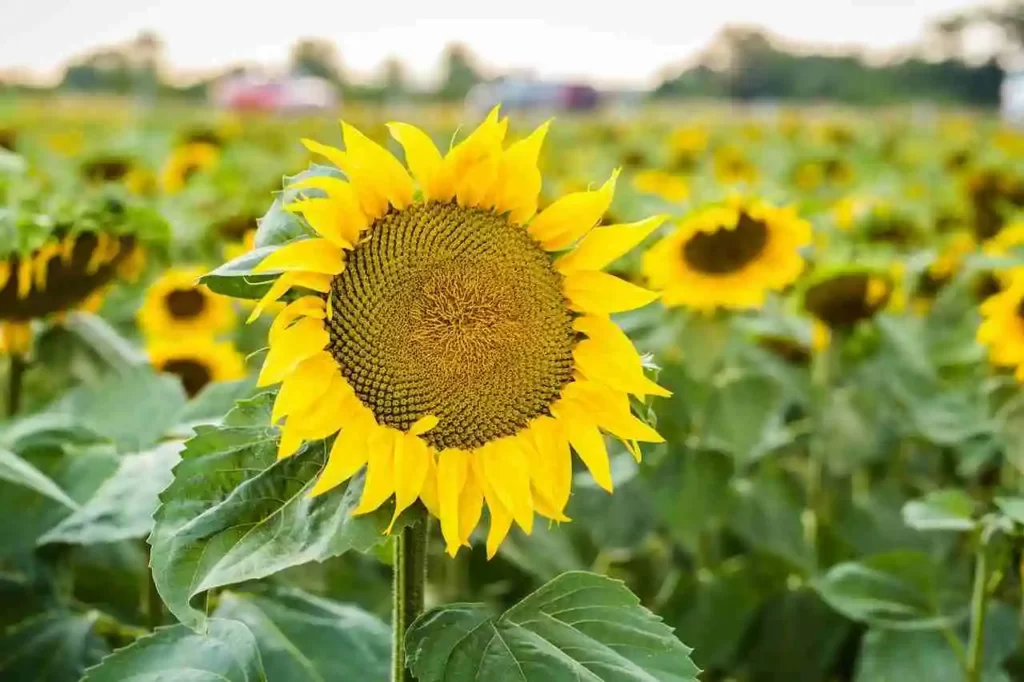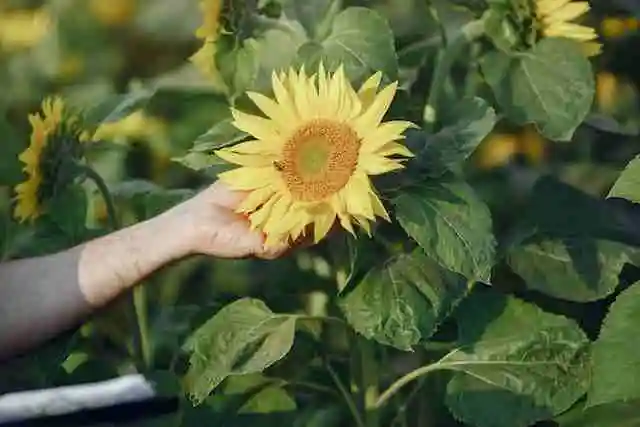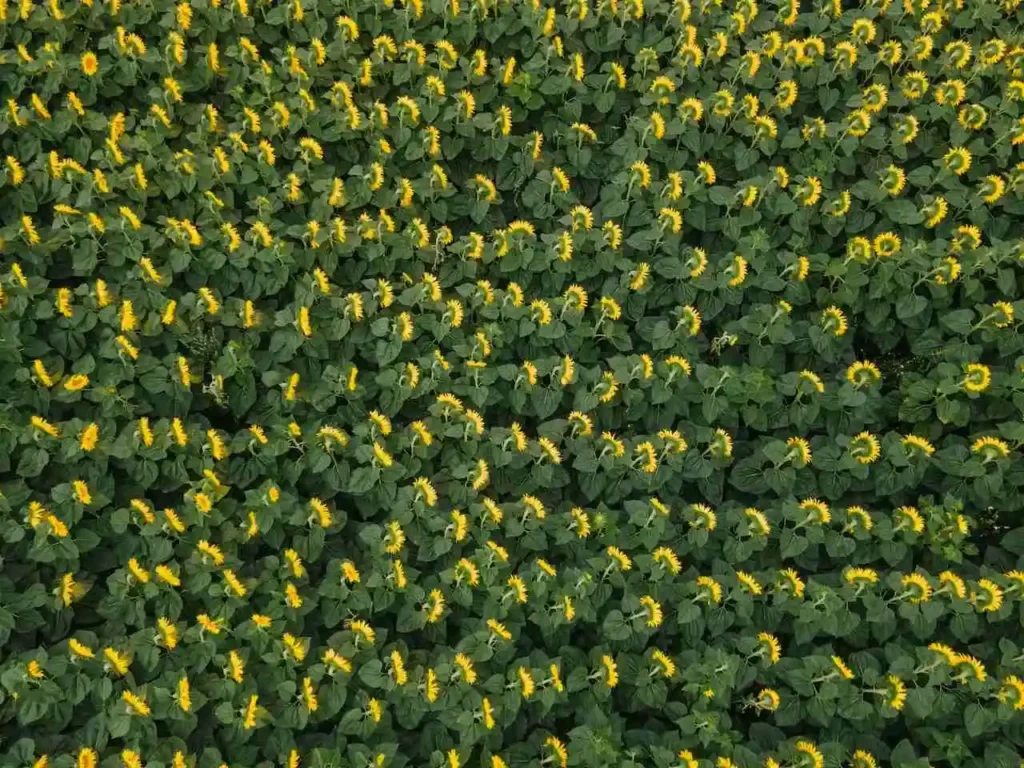Sunflower Farming for Profit: Tips and Strategies for Success
Sunflower Farming: An Overview
Sunflowers are an important oilseed crop that is grown for their seeds, which are rich in oil and used for cooking and other industrial applications. Sunflower farming involves several key steps, including seed production, crop management, variety selection, oil extraction, seed processing, yield improvement, pest control, nutrient management, seed marketing, and seed storage. In this article, we will cover each of these steps in detail.
Sunflowers are a popular crop that is grown for their beauty, versatility, and numerous uses. From being used as an ornamental plant to being processed for oil, bird seed, and even as a source of biofuel, sunflowers have a wide range of applications. If you’re interested in starting your own sunflower farm, read on to learn more about the steps involved in growing and harvesting sunflowers.
Here in this topic, you will get to know below points
- Sunflower seed production
- Sunflower oil extraction
- Sunflower crop management
- Sunflower varieties for farming
- Sunflower growth stages
- Sunflower harvesting and processing
- Organic sunflower farming
- Sunflower pest and disease control
- Sunflower farming business plan
- Sunflower market trends and demand
- Sunflower yield optimization
- Sunflower seed pricing and market analysis
- Sustainable sunflower farming practices
- Sunflower by-products and uses
- Sunflower planting and care guide.

See This =>
Step 1: Choose a Suitable Location
Sunflowers need at least six hours of direct sunlight each day, so it is important to choose a sunny location for your sunflower farm. The soil should be rich in organic matter fertile and well-drained.
Step 2: Prepare the Soil
Before planting, the soil should be tilled to a depth of at least 12 inches to allow for proper root development. The soil should also be tested to determine its pH level and fertility. If necessary, add organic matter or fertilizer to improve the soil quality.
Step 3: Select the Right Variety
There are many different varieties of sunflowers, so it’s important to choose the right one for your location and intended use. If you’re growing sunflowers for oil production, choose a variety that is high in oil content. If you’re growing sunflowers for ornamental purposes, choose a variety that is tall and has large, brightly colored blooms.
Step 4: Sow the Seeds
Sunflower seeds can be sown directly in the ground, or started indoors in pots and then transplanted outside when the weather warms up. Sow the seeds about 1 inch deep, spacing them about 12 inches apart.
Step 5: Water the Seedlings
Sunflowers need to be kept moist while they’re establishing their root systems. Be more careful do not to overwater, because this can cause the seeds rot.
Step 6: Provide Support
As the sunflowers grow, they will become tall and heavy. It is important to provide support in the form of stakes or cages to prevent them from falling over.
Step 7: Fertilize
Sunflowers need regular feeding to produce healthy growth and abundant blooms. Use a balanced fertilizer and apply it every two to four weeks, following the manufacturer’s instructions.
Step 8: Control Pests and Diseases
Sunflowers are relatively resistant to pests and diseases, but it’s still important to keep an eye out for any issues. Keep the area around the sunflowers free of weeds and debris, and treat any pests or diseases as soon as they are detected.
Step 9: Harvest the Sunflowers
The timing of sunflower harvesting will depend on the variety you’re growing and your intended use for the flowers. For ornamental sunflowers, harvest the blooms when they are fully open and the petals are bright yellow. For sunflowers grown for oil production, wait until the back of the flowers has turned brown and the seeds are fully mature. Cut the sunflowers from the plant and remove the leaves and stems.
Step 10: Extract the Oil
If you’re growing sunflowers for oil production, the next step is to extract the oil from the seeds. There are several methods for extracting oil from sunflower seeds, including cold pressing and solvent extraction. Cold pressing involves mechanically pressing the seeds to extract the oil, while solvent extraction uses chemicals to extract the oil. Both methods have their pros and cons, so it’s important to research and choose the method that’s best for your needs.

Step 11: Store the Oil
Once the oil has been extracted from the sunflower seeds, it should be stored in a cool place.
Sunflower Seed Production
Sunflower seeds are the starting point for sunflower farming, and it’s important to choose high-quality seed that is free from pests and diseases. Seed should be treated with an appropriate fungicide or insecticide before planting. Sunflower seeds can be purchased from seed suppliers, or they can be produced on-farm by saving seed from a previous crop. When producing seed on-farm, it’s important to follow appropriate seed-saving procedures to ensure that the seed is pure and free from contaminants.
Sunflower Crop Management
Sunflower crop management involves several key steps, including soil preparation, planting, irrigation, fertility management, and pest control. Sunflowers grow best in well-drained soils with a pH between 6.0 and 7.0, and soil preparation should involve plowing and harrowing the field, as well as adding organic matter to improve soil fertility. Sunflowers are usually planted in rows, with seed drills or broadcast seeding methods used to plant the seed. Irrigation should be applied as needed to keep the soil moist, but not waterlogged. Fertility management should involve regular soil testing and the application of appropriate nutrients based on soil test results. Pest control should involve a combination of cultural, chemical, and biological methods to minimize pest damage and maintain yield potential.
Sunflower Varieties
There are several different sunflower varieties to choose from, each with different growth habits, seed yields, and oil content. Some popular sunflower varieties include Dwarf Sunflowers, which are well-suited for small gardens and cut flowers, and Oilseed Sunflowers, which are grown for their oil and seeds. It’s important to choose a sunflower variety that is well-suited for your growing conditions and that meets your specific production goals.
Here’s a table of some of the popular hybrid commercial varieties of sunflower suitable for different states in India:
| State | Hybrid Variety |
|---|---|
| Uttar Pradesh | NSFH-1, NSFH-7, NSFH-11, NSFH-13 |
| Maharashtra | NSFH-1, NSFH-7, NSFH-11, NSFH-13 |
| Karnataka | NSFH-1, NSFH-7, NSFH-11, NSFH-13 |
| Madhya Pradesh | NSFH-1, NSFH-7, NSFH-11, NSFH-13 |
| Tamil Nadu | NSFH-1, NSFH-7, NSFH-11, NSFH-13 |
| Andhra Pradesh | NSFH-1, NSFH-7, NSFH-11, NSFH-13 |
Note: NSFH stands for National Seed and Farmers Holding Limited. These varieties are popular due to their high yield and tolerance to various environmental factors, but it’s best to consult with local experts and agricultural extension services to determine which varieties are best suited for your specific growing conditions.
Sunflower Oil Extraction
Sunflower oil extraction involves removing the oil from the sunflower seeds. This can be done using several methods, including mechanical pressing or solvent extraction. Mechanical pressing involves mechanically squeezing the oil out of the seeds, while solvent extraction involves using a solvent to extract the oil. The choice of extraction method will depend on the scale of production and the desired quality of the oil.
Sunflower Seed Processing
Sunflower seed processing involves cleaning, grading, and packaging the seeds to meet market specifications. Seed cleaning involves removing foreign material, broken seeds, and other contaminants from the seeds, while grading involves separating the seeds based on size and quality. Packaging is the final step in sunflower seed processing, and it’s important to use high-quality packaging materials to ensure that the seeds are protected during transport and storage.

Sunflower Seed Yield
Sunflower seed yield is an important measure of the success of sunflower farming, and it can be influenced by several factors, including seed quality, crop management, nutrient management, pest control, and weather conditions. It’s important to monitor seed yield regularly and to make adjustments to crop management practices as needed to maintain or improve seed yield.
Sunflower Pest Control
Sunflowers are susceptible to a range of pests, including aphids, cutworms, armyworms, and sunflower
Sunflower Seed Storage
Sunflower seed storage is an important aspect of sunflower farming, as it ensures that the seed remains in good condition until it is sold or processed. Sunflower seeds should be stored in a cool, dry place, with a temperature of about 60-70°F and relative humidity of about 50%. Seed storage should also be free from pests and other contaminants, and seed storage containers should be properly sealed to prevent moisture and insect damage. Sunflower seeds should be inspected regularly during storage and any seed that shows signs of insect damage or other contaminants should be removed. Proper sunflower seed storage helps to maintain seed quality and maximizes seed value.
In conclusion, sunflower farming involves several key steps, including seed production, crop management, variety selection, oil extraction, seed processing, yield improvement, pest control, nutrient management, seed marketing, and seed storage. By following best practices for each of these steps, sunflower farmers can produce high-quality seeds and oil and maximize their returns from sunflower farming.
How you can earn from sunflower farming with calculation
Sunflower farming can be a profitable business if done correctly. Here’s an example of how you could potentially earn from sunflower farming:
- Sunflower seed production: You can sell sunflower seeds as a whole food product or as bird seed. The wholesale price for sunflower seeds is around $1-$2 per pound. Let’s assume you plant an acre of sunflowers and average 2,000 pounds of sunflower seeds per acre, so you could potentially earn $2,000 to $4,000 from seed production alone.
- Sunflower oil production: Sunflower oil is a popular cooking oil and can also be used in cosmetic and industrial products. The wholesale price for sunflower oil is around $0.50-$1.50 per pound. Let’s assume you extract 40 pounds of oil from every 100 pounds of sunflower seeds, so you could potentially earn $20 to $60 from oil production for every 100 pounds of sunflower seeds.
- Sunflower by-products: In addition to sunflower seeds and oil, there are other by-products of sunflower farming that you can sell, such as sunflower meal (the residue left after oil extraction) and sunflower stalks (which can be used as livestock feed or for industrial applications).
It’s important to keep in mind that these figures are just estimates and actual earnings will depend on many factors, including the cost of production, the yield of your crops, and the current market conditions for sunflowers and sunflower-derived products. To get a more accurate idea of your potential earnings, it’s best to research current prices and yields, as well as the costs of production, including seeds, fertilizer, labor, and equipment.
Note: This is just an estimate, actual earnings will depend on various factors such as the cost of production, the yield of crops, and the market price of sunflower and its by-products.
Sunflower farming countries and list of the top importing and exporting country
Sunflowers are grown in many countries across the world. Some of the major sunflower-producing countries include:
- Russia: Russia is the largest producer of sunflowers in the world, producing over 9 million tonnes of sunflowers annually.
- Ukraine: Ukraine is the second largest producer of sunflowers, producing over 7 million tonnes of sunflowers annually.
- France: France is a major producer of sunflowers, producing over 3 million tonnes of sunflowers annually.
- Argentina: Argentina is a major producer of sunflowers, producing over 2 million tonnes of sunflowers annually.
- Italy: Italy is a significant producer of sunflowers, producing over 1 million tonnes of sunflowers annually.
In terms of sunflower imports and exports, some of the major importing and exporting countries include:
- China: China is a major importer of sunflower seeds, mainly from Russia and Ukraine.
- European Union: The European Union is a major importer of sunflower seeds, mainly from Russia and Ukraine, as well as a major exporter of sunflower oil.
- Turkey: Turkey is a major importer of sunflower seeds and a major exporter of sunflower oil.
- United States: The United States is a major importer of sunflower seeds and a significant exporter of sunflower oil.
- India: India is a significant importer of sunflower seeds and a major exporter of sunflower oil.
It’s important to note that these figures are subject to change and are based on data from 2021, so it’s best to check the latest data for the most up-to-date information on sunflower imports and exports.
Crop rotation in sunflower production
Crop rotation is an important aspect of sunflower production, as it helps to reduce the risk of soil-borne diseases, pests, and nutrient imbalances. A good crop rotation system for sunflowers would involve rotating the crop with other crops that belong to different plant families to reduce the buildup of soil-borne pathogens and pests.
For example, a common crop rotation for sunflowers might involve planting sunflowers in a field one year, followed by a legume crop such as soybeans or peas the next year, and then a cereal crop such as wheat or corn the year after that. This type of crop rotation helps to improve soil fertility, reduce disease and pest pressure, and maintain soil health.
It’s important to remember that crop rotation is just one aspect of a comprehensive sunflower production system and that other factors such as soil preparation, fertility management, pest control, and harvest management also play a critical role in achieving high yields and good quality sunflowers.
Here are some frequently asked questions (FAQs) related to sunflower farming, along with detailed information:
- What is sunflower farming? Sunflower farming is the cultivation of sunflower plants for the purpose of producing sunflower seeds, oil, and other by-products. Sunflower seeds are a rich source of oil and can be used for a variety of purposes, including human consumption, animal feed, and biofuel production. Sunflower farming requires a combination of agronomic practices, such as proper seed selection, soil preparation, planting, irrigation, pest control, and harvesting.
- How long does it take for sunflowers to grow? The time it takes for sunflowers to grow depends on several factors, including variety, climate, soil type, and growing conditions. On average, sunflowers take about 100-120 days from seedling to maturity. Faster-growing varieties can mature in as little as 70-80 days, while slower-growing varieties may take up to 150 days or more.
- What is the best soil for sunflower farming? Sunflowers prefer well-drained soil with a neutral to slightly acidic pH of 6.0 to 7.0. The soil should be fertile, with adequate amounts of organic matter, nitrogen, phosphorus, and potassium. Sunflowers are not tolerant of waterlogged or poorly drained soils, as they can suffer from root rot.
- What is the best time to plant sunflowers? The best time to plant sunflowers depends on the climate and growing conditions in your region. In general, sunflowers are best planted when the soil temperature has reached a minimum of 50°F (10°C). This is typically when the threat of frost has passed, and the soil is warm enough for the seeds to germinate.
- How often should sunflowers be watered? Sunflowers need to be kept consistently moist, especially during the first few weeks after planting. The frequency of watering will depend on several factors, including the climate, soil type, and growing conditions. In general, sunflowers should be watered deeply at least once or twice a week, providing enough water to reach the roots. It’s important to avoid over-watering, as this can lead to root rot and other problems.
- How do you control pests and diseases in sunflower farming? Pest and disease control is an important aspect of sunflower farming. To minimize pest and disease problems, it’s important to follow good cultural practices, such as crop rotation, proper irrigation, and crop sanitation. Other strategies for controlling pests and diseases include the use of resistant varieties, biological control, and the judicious use of pesticides and fungicides.
- What is the average yield of sunflowers per acre? The average yield of sunflowers per acre can vary greatly, depending on several factors, including the variety, climate, soil type, and growing conditions. On average, sunflower yields can range from 1,500 to 2,500 pounds per acre, with the highest yields typically achieved under favorable growing conditions. Yields can be improved through proper crop management, including adequate irrigation, fertilization, and pest control.
How much earning we can earn by doing sunflower farming
The earning potential from sunflower farming in Indian Rupees (INR) depends on several factors, including the size of the farm, the yield per acre, the price of sunflower seeds and oil, and the cost of inputs such as seeds, fertilizer, labor, and machinery. On average, a sunflower farm of 50 acres can earn a profit of around 2.8 million to 4.2 million INR per year, but this can vary greatly depending on the specific conditions of the farm and the market prices for sunflowers.
To get a more accurate estimate of the potential earnings from sunflower farming, you should consider factors such as the cost of inputs, the expected yield per acre, and current market prices for sunflower seeds and oil. You should also factor in any government support or subsidies available for sunflower farming in your area.
It’s also important to note that sunflower farming can be a risky business, as it is subject to factors such as weather conditions, disease outbreaks, and market fluctuations, which can affect the yield and profitability of the farm. Therefore, it is important to conduct thorough research and seek expert advice before starting a sunflower farming venture.
Here’s an example of earnings from 1 acre of sunflower farming:
Here’s an example of earnings from 1 acre of sunflower farming in Indian Rupees (INR):
Assuming an average yield of 1,500 pounds of seed per acre and a market price of 35 INR per pound, the total revenue from seed sales would be 52,500 INR. If the farm also produces sunflower oil, with an average yield of 50 gallons per acre and a market price of 2,250 INR per gallon, the total revenue from oil sales would be 1,12,500 INR.
Please note that the exchange rate is constantly fluctuating, so these values may not reflect the current market prices. Additionally, actual earnings will depend on various factors such as weather conditions, disease outbreaks, market prices, and costs of inputs such as seeds, fertilizer, labor, and machinery. The cost of inputs will depend on the specific conditions of the farm, the technology and practices used, and the location of the farm.
It’s also important to note that this example does not take into account the costs of production, which can vary greatly and can significantly impact the profit margins of the farm. Some common costs of sunflower farming include seed costs, fertilizer, herbicides, labor, and machinery costs. To get a more accurate estimate of the potential earnings from sunflower farming, you should consult an agricultural expert or specialist.
You Can read this too
